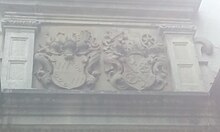Marienkirche (Lauda)
The Roman Catholic St. Mary's Church , formerly also called the Church of Our Lady , in Lauda was built in the 17th century. She belongs to the pastoral care unit Lauda-Königshofen, which is assigned to the deanery Tauberbischofsheim of the Archdiocese of Freiburg .
history
The origins of the Marienkirche go back to the 14th century. The church in its current form was built in 1613 and 1617 on the cemetery that was laid out in 1542. At the request of the then Würzburg prince-bishop Julius Echter von Mespelbrunn, it was built in the Julius style, which is characterized by a pointed tower and a magnificently designed north portal.
coat of arms
Coat of arms above the main entrance
In the top of the north portal are the two coats of arms of Julius Echter von Mespelbrunn and Johann Gottfried von Aschhausen . Both were prince-bishops in Würzburg and Bamberg. They were also the builders and thus provided funds for the construction of the church. The optically left coat of arms belongs to Julius Echter von Mespelbrunn, the right to Johann Gottfried von Aschhausen.
Coat of arms above the side entrance
The coat of arms above the west portal also belongs to the Würzburg prince-bishop Julius Echter von Mespelbrunn. The coat of arms is quartered. In the first field of the coat of arms is the Franconian rake. In fields two and three there are diagonal bars with three rings. In the fourth field is the so-called racing flag. This is the typical coat of arms of the Prince-Bishop.
Furnishing
The Marienkirche is characterized by its magnificently designed interior. It contains a main altar as well as two side altars and numerous paintings.
Altars
Main altar
The baroque main altar presumably comes from the Upper Palatinate Johann Doser . The reredos depicts the fourth and fifth movements of the Glorious Rosary , namely the Assumption of Mary into heaven and her coronation. Behind a gathered curtain, Mary floats towards the Holy Trinity . In the excerpt, angels hold the crown ready for them. The left assistant figure is Saint Barbara with a goblet and sword in her hands in front of an indicated tower. On the right in the main altar is St. Catherine of Alexandria with the wheel as a reference to her martyrdom . The carved candle holders on both sides of the tabernacle are the work of the sculptor Georg Winterstein. Anton Herbith from Karlstadt am Main built the tabernacle .
Right side altar
The right side altar is probably the work of the sculptor Anton Grimbach from Bühlertann . He shows the statue of St. Joseph . The foster father of Jesus carries the baby Jesus in his arm and a lily in his right hand. The Archangel Michael stands above the head of the altar as a harbinger of the Last Judgment with the scales and the flaming sword.
Left side altar
The left side altar, built in 1887 by Julius Seitz from Munich, bears a crucifix that is flanked by an angel on the right and left. The pyramid-shaped top carries a grave urn . The rising horse in the red field is the sable coat of arms . The noble family Zobel from Giebelstadt were wealthy in Lauda. The ten thousand talents promissory note is an allegory . Humanity owed infinitely great debt to God because of its great sinfulness . Christ has, as it were, redeemed this bond through his sacrificial death on the cross.
painting
Ceiling fresco
The monumental ceiling fresco, like the main altar, depicts the Assumption of Mary . It shows the Blessed Mother floating above the grave from which, according to legend, lilies have sprouted. She is guided by angels as she floats towards the Holy Trinity. On the left side you can see apostles who watch the events in amazement. In the background you can see a silhouette of St. Peter's Basilica, in front of which St. Peter stands with a portrait of Pope Leo XIII. Next to Peter stands Paul, who bears a portrait of the then Freiburg Archbishop Johann Christian Roos. In the hollow there are eleven medallions that contain events that are references to the Mother of God. The medallions also represent the architectural connection between the walls and the ceiling. The fresco and the medallions were created in 1887 and are works by the artist Waldemar Kolmsperger .
Painting over the south door
The painting above the south door shows the birth of Jesus. The Adoration of the Shepherds is also shown, which shows Mercy, Mary's greatest joy. The painting was created by Waldemar Kolmsperger.
Painting over the north door
As we leave the church, we see the Mother of Sorrows holding her dead son on her lap. The painting was also created by Waldemar Kolmsperger.
Views of the Church
Way of the Cross
In the cemetery wall of the city cemetery outside the Marienkirche there is a 14-station, high baroque Way of the Cross from 1782.
Web links
Individual evidence
- ↑ a b LEO-BW.de: Church (Bahnhofstrasse 16, Lauda-Königshofen) . Online at www.leo-bw.de. Retrieved October 17, 2018.
- ^ Deanery Tauberbischofsheim: Pastoral conception of the Deanery Tauberbischofsheim . (PDF, 1.3 MB). Resolution of July 21, 2011. Online at www.kath-dekanat-tbb.de. Retrieved December 26, 2015.
- ^ Deanery Tauberbischofsheim: Pastoral care units of the Deanery Tauberbischofsheim . Online at www.kath-dekanat-tbb.de. December 26, 2015.
- ^ Taubertal.de: Marienkirche Lauda . Online at www.taubertal.de. Retrieved March 11, 2016.
- ↑ a b c d e f g h i j Pastoral care unit Lauda-Königshofen: Marienkirche . Online at www.kath-lauda-koenigshofen.de. Retrieved March 11, 2016.
- ↑ a b Bernhard Peter: The Marienkirche in Lauda . Online at www.welt-der-wappen.de. Retrieved June 30, 2016.
Coordinates: 49 ° 34 ′ 9 ″ N , 9 ° 42 ′ 19 ″ E











